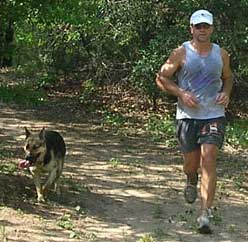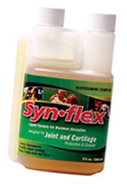| Running Knee Pain
Causes, Preventions and Cures


Athletes who have knee pain when running want an easy solution to the problem. Fortunately, new shoes and strengthening foot and leg muscle groups may help eliminate the pain.
It’s important to make sure the problem isn’t due to injury or a medical condition. The doctor may be able to eliminate more serious sources of trouble in one visit, but other conditions require more attention. Torn ligaments, cartilage or meniscus may require surgical treatment. Bursitis and osteoarthritis may require other non-surgical medical intervention for easing knee pain while running.
When serious treatable conditions are eliminated, running routine, equipment and muscle conditions must be examined.
One of the easiest things to check is the running shoe. Uneven wear on one side of a shoe indicates pronation or rolling of the foot while running. Pronation causes poor alignment in the leg and knee, leading to swelling and pain in the knees.
Glucosamine Works!



I’ve been running seriously since I was 40 years old. For the first three years of running I was plagued with knee pain off and on. It doesn’t seem to matter what age people are when they begin; running knee pain can be a problem. It’s hard to go to a road race without hearing some runners complaining of knee problems.
A good athletic or running shoe store will have a device to detect pronation, and they can recommend the right shoe to correct the problem. Orthotic inserts can make a good shoe a great shoe.
Glucosamine for Runners Alleviates Pain
Liquid Glucosamine Advantages:
- Get a FULL 1500 mg of Glucosamine in Each Dose
- Better and More Quickly Absorbed
- Unlike Pills or Capsules There Are No Fillers
- Lower In Price

 |
Glucosamine is a dietary supplement that aids the production of cartilage and protects existing cartilage from damage. Glucosamine for runners is recommended by doctors to alleviate joint pain caused by the sport that they love.
Available since the 1980s, this supplement is available in tablet and liquid form. Most doctors recommend taking 1500 mg daily with a beverage.
Glucosamine for runners is produced from the skeletons of shellfish or from corn. Those allergic to fish often do not suffer any ill effects from this drug. The human body produces this natural compound which in turn manufactures glucosamine to repair cartilage of the joints. If production of this compound is lacking and causing slow healing, doctors often recommend supplements which will speed the healing of the affected joints. This medication is available without a prescription, but it is best to consult a physician prior to using.
This product does not cause damaging side effects to internal organs like aspirin and ibuprofen when taken for long periods. Side effects include nausea, vomiting, diarrhea or constipation, abdominal pain, drowsiness, headache, insomnia, poor appetite, or heartburn. Glucosamine for runners needs to be protected from light and moisture and kept in a sealed container. Without FDA approval, pregnant women should not take the medication since effects on the baby are not known. Although studies have shown that taking the drug will not significantly affect glucose levels, diabetics are recommended to monitor their blood sugar levels while taking the medication for any fluctuation. Positive effects from taking the medication are long lasting and will continue even if the consumer stops taking the product.
Glucosamine for runners is used by those suffering joint pain, especially knee pain which is the runner’s number one pain complaint. Arthritis suffers also find lasting relief from the product. It protects existing cartilage, repairs damaged cartilage, and promotes the production of cartilage in the joints. Runners can obtain the drug without the need for a doctor’s prescription and feel the much needed immediate results.
My Runner's Knee Pain Story
by Steve Weber
I was 40 years old when I began my “official” running career. It was December of that year when I had my worst running experience with runner’s knee. My “long run” was up to about 4 miles and I had my sites set on an early spring half-marathon. That was my first mistake; I didn’t realize the time and effort required to successfully complete a half-marathon…especially at that age.
I decided that it was time to “ramp up” my long run distances. No, I didn’t have a running schedule and I had never read a book on running. Although I had had some knee pain while running, I still estimated I was good for a 10 mile run on the coming weekend. I was really getting into that running!
That Saturday morning was windy and cold. I bundled up and had my wife drive me 10 miles into the country and drop me off. The first few miles I felt great and life was good!
After running 3 miles or so I felt some slight knee pain. I had felt it before and it had never been a problem (of course my long runs were no more than 3 or 4 miles up to that point). By mile number 4, I knew I had a problem going on.
Finally, at 5 miles, I had to stop and walk because of the knee pain. I had a full fledged case of runner’s knee. After walking a hundred yards I began running again; the pain came back after only a few steps.
But it was cold and windy. I was getting cold so I decided to run with the pain.
By mile 7 I was walking about one-hundred yards and running 20. Things were going down hill fast for me. On a scale of 1 to 10, my runner’s knee pain was at least a 10. I did not have my cell phone; otherwise I would have called my wife to come rescue me.
After finishing 9 miles, I was walking 100% of the time. I was barely able to lift my right leg at each step. Worse still, my left knee had begun hurting too. I was a pitiful mess by the time I got home. I literally had to go up the front porch steps one leg at a time. No way could I lift my right leg onto a step.
Luckily, runner’s knee usually heals fast. In 3 or 4 days I was pretty much back to normal and vowed to keep my long runs within reason.
Oh, and I did run that half-marathon in the spring. But it was ugly. After that race, I decided to read some books on running. I got on a good training schedule and ran a full marathon the next year…without any knee pain.
Steve Weber

Here I am with my running buddy, Avie
|


The muscles that operate the knee, the hamstrings and the quadriceps, are important to the proper alignment of the knee. If the hamstrings are stronger than the quadriceps, it disturbs the motion of the kneecap floating over the joint as the runner strides.
Experts recommend straight leg lifts to begin strengthening the quads. Lie on the floor with one leg slightly bent. Lift the straight leg ten times, rest and repeat on the other side. Five sets of ten are a good starting place with ten sets of ten as the goal. Weight lifting can strengthen the quads, but is not recommended as a beginning step, since bending the knee will probably be painful.
Core strengthening is good for everyone and some suggest it will also aid in knee stabilization. Work the abs and the back to strengthen the core. Try the classic yoga move called the plank. Push the body up on hands and toes in the classic push-up position and hold for thirty seconds. Do stomach crunches for upper abs and lift both legs together to work the lower abs.
Stretch the posterior, hamstrings and calves before running. Stretching and lengthening the muscle at the back of the thigh is particularly important.
#1
Don’t Over Do It
The number one reason people will suffer from running knee pain is that they run too far, too often. No matter who you are, if you go from zero miles to 15 miles per week in a month’s time, you will have problems. Everyone is different, so there is no set weekly mileage beginning runners should adhere. One must simply pay close attention to their body and LISTEN to it! Slow your training rate down at the first sign of running knee pain. Otherwise you will HAVE to stop for 3 or 4 days to allow yourself to heal. This is one of the hardest things for new runners to do. Always remember the brain is much more powerful than the body. We can easily force ourselves right past the point of prudence and toward an injury.
#2
Correct Shoes Are a Must!
Another source of running knee pain is from wearing the wrong shoes. $39.99 Nike “running” shoes from Walmart simply won’t do. Your first pair of running shoes needs to be purchased from a real running store where the knowledgeable staff can fit you with the correct shoe. Correct running shoes don’t just fit right, they are designed to support your arch correctly as you run. Your arch may not need any support, or it may need a lot. You must be fitted with the correct shoe to prevent all kinds of problems, not just running knee pain. Walmart and shoe stores in the mall do not sell real running shoes. Don’t buy yours there. Find a running store and expect to pay $80 to $120 for your pair of running shoes. After you find the exact brand and model of shoe which is right for you, you can usually order the same pair on the Internet for 10% to 25% less. But you MUST go to a running store to find that first pair which is just right for your step.
#3
Watch Out for Those Hard Surfaces!
Even with the correct shoes, running knee pain can still be a problem if much of your running is done on pavement. For most of us, our choice of good running locations which aren’t paved are few and far in between. But look around. Your knees will thank you if you can find some grassy or dirt trails once in a while. I also have found rubberized tracks are easy on the joints. Check with your local high school or university. If they have a rubberized track, see if they allow public access. We are lucky at our home. We made a third-mile winding trail through our pasture. Dirt trails are easy on your knees! However, here is a warning: If your long races will be on hard surfaces, at least some of your training each week should be on those harder surfaces.
#4
Eating for Running
Lastly, make sure your diet is correct. Running is high impact and great for building strong bones and joints. But the process of growing and repairing new and damaged joint tissue requires the right nutrition. Luckily, running will create cravings for the “right” foods. Fried burritos in quick shops simply don’t look as good as they used to! Instead, Subway sandwiches are the fast food of choice for runners.
#5
Glucosamine for Healthy Joints
Because of our fast pace lifestyles, most runners choose supplementation to ensure they receive their proper daily nutrition. One of the most common supplements runners use is glucosamine. Glucosamine is well known for helping maintain healthy joints and regenerating damaged cartilage. Glucosamine is a naturally occurring substance which is completely safe with no side effects. It’s inexpensive, the liquid form is easy to take, and thousands of athletes are true believers of its benefits. Click here for more information about using glucosamine to insure healthy joints.
Knee Pain caused by overuse will require an alternate fitness routine while the inflammation and swelling go away. Most fitness experts currently tell their clients to work different muscle groups on successive days. If the knees are painful while running, try swimming or biking on off days. Swimming is great aerobic exercise that uses the knee in a very different motion while eliminating impact.
After running, remember the RICE. REST the knee. Apply ICE. Use COMPRESSION to keep the kneecap aligned. ELEVATE the knee. An anti-inflammatory drugs such as ibuprofen can help. Ibuprofen should not be taken for more than ten days in a row. If knee pain and swelling are persistent after and while running and continue past bedtime to interfere with sleep, ask a doctor for assistance.
Knee pain when running may slow down a runner, but it shouldn’t cause a runner to stop permanently. Simple fixes like strengthening exercises and the right shoes will help a runner deal with knee pain on a long term basis without surgery or medication.
If you are suffering from running knee pain, first make sure you follow the above advice as closely as possible. But if joint pain seems to become a chronic problem, you may want to visit a sports doctor. Don’t waste your money going to your regular MD. Go to a sports doctor who understands running and runners. Your regular doctor will simply tell you to “stop running for a while”. He won’t be able to analyze your situation and get to the root of the problem like a sports doctor will.
|












